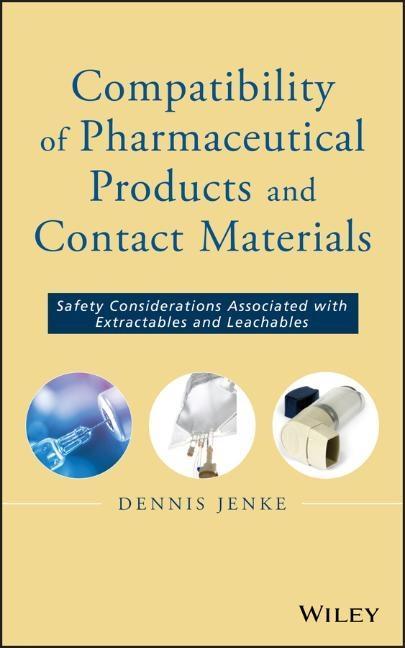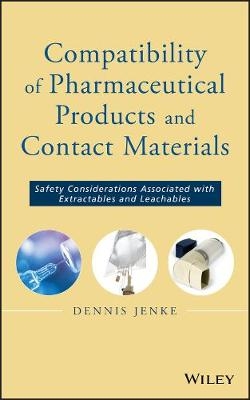
2009, ISBN: 9780470281765
Hard cover, Fine., Glued binding. Paper over boards. 400 p. Contains: Unspecified, Line drawings, black & white, Tables, black & white, Figures. In Stock. 100% Money Back Guarantee. Brand… Altro …
| alibris.co.uk |

Compatibility of Pharmaceutical Solutions and Contact Materials: Safety Assessments of Extractables and Leachables for Pharmaceutical Products - edizione con copertina flessibile
ISBN: 9780470281765
*Compatibility of Pharmaceutical Solutions and Contact Materials: Safety Assessments of Extractables and Leachables for Pharmaceutical Products* / gebundene Ausgabe für 184.99 € / Aus dem… Altro …
| Hugendubel.de 0470281766. Costi di spedizione:Shipping in 2 weeks, , Versandkostenfrei nach Hause oder Express-Lieferung in Ihre Buchhandlung., DE. (EUR 0.00) Details... |

2009, ISBN: 9780470281765
edizione con copertina rigida
[ED: Gebunden], [PU: John Wiley & Sons], Dennis Jenke is Principal Scientist in the Technology Resources Division of the Baxter Healthcare Corporation. He works with a team of analytical … Altro …
| booklooker.de |

Compatibility of Pharmaceutical Solutions and Contact Materials: Safety Assessments of Extractables and Leachables for Pharmaceutical Products - copertina rigida, flessible
2009, ISBN: 0470281766
[EAN: 9780470281765], Neubuch, [PU: Wiley-Interscience], New!, Books
| AbeBooks.de Paper Cavalier Bazaar, London, United Kingdom [86406241] [Rating: 4 (von 5)] NEW BOOK. Costi di spedizione: EUR 9.37 Details... |

Compatibility of Pharmaceutical Products and Contact Materials ? Safety Considerations Associated with Extractables and Leachables - copertina rigida, flessible
2009, ISBN: 9780470281765
Buch, Hardcover, [PU: John Wiley & Sons Inc], John Wiley & Sons Inc, 2009
| lehmanns.de Costi di spedizione:Versand in 10-15 Tagen. (EUR 0.00) Details... |

2009, ISBN: 9780470281765
Hard cover, Fine., Glued binding. Paper over boards. 400 p. Contains: Unspecified, Line drawings, black & white, Tables, black & white, Figures. In Stock. 100% Money Back Guarantee. Brand… Altro …

Dennis Jenke:
Compatibility of Pharmaceutical Solutions and Contact Materials: Safety Assessments of Extractables and Leachables for Pharmaceutical Products - edizione con copertina flessibileISBN: 9780470281765
*Compatibility of Pharmaceutical Solutions and Contact Materials: Safety Assessments of Extractables and Leachables for Pharmaceutical Products* / gebundene Ausgabe für 184.99 € / Aus dem… Altro …

2009
ISBN: 9780470281765
edizione con copertina rigida
[ED: Gebunden], [PU: John Wiley & Sons], Dennis Jenke is Principal Scientist in the Technology Resources Division of the Baxter Healthcare Corporation. He works with a team of analytical … Altro …
Compatibility of Pharmaceutical Solutions and Contact Materials: Safety Assessments of Extractables and Leachables for Pharmaceutical Products - copertina rigida, flessible
2009, ISBN: 0470281766
[EAN: 9780470281765], Neubuch, [PU: Wiley-Interscience], New!, Books

Compatibility of Pharmaceutical Products and Contact Materials ? Safety Considerations Associated with Extractables and Leachables - copertina rigida, flessible
2009, ISBN: 9780470281765
Buch, Hardcover, [PU: John Wiley & Sons Inc], John Wiley & Sons Inc, 2009
Dati bibliografici del miglior libro corrispondente
| Autore: | |
| Titolo: | |
| ISBN: |
Informazioni dettagliate del libro - Compatibility of Pharmaceutical Solutions and Contact Materials: Safety Assessments of Extractables and Leachables for Pharmaceutical Products
EAN (ISBN-13): 9780470281765
ISBN (ISBN-10): 0470281766
Copertina rigida
Copertina flessibile
Anno di pubblicazione: 2009
Editore: WILEY
379 Pagine
Peso: 0,658 kg
Lingua: eng/Englisch
Libro nella banca dati dal 2009-05-09T13:51:15+02:00 (Zurich)
Pagina di dettaglio ultima modifica in 2023-11-13T17:49:14+01:00 (Zurich)
ISBN/EAN: 0470281766
ISBN - Stili di scrittura alternativi:
0-470-28176-6, 978-0-470-28176-5
Stili di scrittura alternativi e concetti di ricerca simili:
Autore del libro : jenke
Titolo del libro: contact, safety, materia pharmaceutica
Dati dell'editore
Autore: Dennis Jenke
Titolo: Compatibility of Pharmaceutical Solutions and Contact Materials - Safety Assessments of Extractables and Leachables for Pharmaceutical Products
Editore: John Wiley & Sons
400 Pagine
Anno di pubblicazione: 2009-06-19
Peso: 0,752 kg
Lingua: Inglese
145,00 € (DE)
No longer receiving updates
157mm x 240mm x 26mm
BB; Hardcover, Softcover / Chemie; Medizinische Chemie, Pharmazeutische Chemie; Analytical Chemistry; Analytische Chemie; Arzneimittelforschung; Chemie; Chemistry; Drug Discovery & Development; Toxicology; Toxikologie; Wirkstoffforschung u. -entwicklung; Analytische Chemie; Wirkstoffforschung u. -entwicklung; Toxikologie
PREFACE AND ACKNOWLEDGMENTS. PART A GENERAL CONCEPTS. 1. Introduction. General Discussion. Key Definitions. The Interacting Parties. Extractables versus Leachables. Regulatory Perspectives for Performing Compatibility and/or Safety Assessments. The U.S. Food and Drug Administration Guidance for Industry: Container Closure Systems for Packaging Human Drugs and Biologics. European Medicines Agency (EMEA) Guideline on Plastic Immediate Packaging Materials. FDA Guidance for Industry, Inhalation Products. Medical Devices. An Overview of Strategies for Performing Safety Assessments. The Generalized Strategy for Safety Assessments. Moving Forward. References. 2. Nomenclature and General Concepts. General. Nomenclature. Primary Definitions. Constituents of a Material or Construct. Classification of Extracting Media. Classification of Extraction Strategies. Example Extraction Conditions Applied to a Model System. Correlation. Factors That Influence the Linking of Extractables and Leachables. A Hierarchy for Linkages between Extractables and Leachables. Decisions Concerning the Required Rigor for Linkages. Circumstances Requiring the Linking of Extractables and Leachables. Identification and Quantitation. Risks and Risk Management. Risk Categories Related to Biological Assessment of Medical Devices. Risk Categories Related to Assessment of Primary Packaging and/or Container-Closure Systems. The General Dimensions of Risk. Utilization of Risk Classification Profiles. Risk Classification in Indirect Contact Situations. The Construct Itself as a Contributor to Risk. References. 3. Extractables, Leachables, and the Product Life Cycle. General. Discussion of the Components of the Master Flow Diagram. Observations. Application of the Process Map. PART B MATERIAL CHARACTERIZATION. 4. Material Screening and Characterization. Overview. General Principles. Compendial Compliance. United States Pharmacopeia. Japanese Pharmaceopeia. European Pharmacopeia. Compositional Characterization, General Concepts. Compositional Characterization by Collecting Available Material Information. General. Collecting Extractables Information from the Material Supplier. Compositional Characterization by Material Testing, Extractables Survey. Extractables Survey: Extraction. Case Studies: The Influence of Extraction Medium on the Extractables Survey. Extractables Survey: Extract Analysis. Case Study: Extractables Survey for Plastic Tubing Materials. Case Study: Extractables Survey for an Elastomer Used in OINDP. Case Study: Extractables Survey for a Rubber Closure Used with Semisolid Drug Products. Case Study: Extractables Survey for Filter Cartridges Used in Downstream Processing of Pharmaceuticals. Bibliography of Analytical Methods. Reconciliation as a Survey Tool. Case Study: TOC Reconciliation; Characterization of a Polyolefin Material. Use of Extractables Information in Safety Assessment: Extractables Profile, Total Pool, and Total Available Pool. Extractions to Establish the Total Pool and Total Available Pool. Case Study: Total Pool Determination by Successive Extraction. Recap: Components of a Complete Extractables Assessment. Caveats in Using Extractables Information for Safety Assessment. Chemical Characterization: Device Perspective per ISO 10993-18. References. PART C CONSTRUCT QUALIFICATION. 5. The Prototype Stage. General Comments. The Simulation Study. Generating the Simulating Extract. Simulating the Contact Parameters. Simulating the Therapeutic Product. Simulating the Exposure Parameters. Analyzing the Simulating Extract. Case Study: Modeling of the Impact of Solubilizing Agents on Leachables Accumulation. Case Study: Accumulation of Organic Leachables from Plastic Biopharmaceutical Process Containers. Case Study: Accumulation of Label-Related Leachables in a Solid Dosage Form. Case Study: Accumulation of Caprolactam Oligomers Leached from Nylon-6 Material. Application of the Analytical Threshold. The Preliminary Toxicological Assessment. Case Study: Assessment of Cyclohexanone Limits for Containers. Exiting the Prototype Stage. References. 6. The Early Development Stage. General Comments. Target Leachables. Method Development, Evaluation, and Validation. Method Development (Optimization). Prerequisites to Method Optimization. Overview of the Method Optimization Process. Conduct of a Method Optimization Study. Primary Performance Assessment. Troubleshooting Guide. Secondary Performance Assessment. System Suitability. Robustness. Exiting Method Development-Optimization. The Method Evaluation Process. General. Aspects of the Evaluation and Validation Processes. Overview of the Method Evaluation Process. Template for the Conduct of a Method Evaluation Study. Validation. Case Study: Validation of an LC/MS Method for the Quantitation of Leachables from a Packaging System. General. Experimental. Validation Study. Case Study: Validation of an HPLC Method For Quantitating Stopper Leachables in a Complex Surfactant Vehicle. General. Validation. Exiting the Early Development Stage. References. PART D CONSTRUCT VALIDATION. 7. Late Stage Product Development. General: The Migration Study. Design of the Migration Study. EMEA Guideline on Plastic Immediate Packaging Materials. FDA Guidance. Optimal Design of a Migration Study. Interpretation of the Migration Study: Toxicological Assessment. Disaster Management. Class A Disaster: Unusual or Unexpected Change in the Concentration of a Target Leachable. Class B Disaster: A Previously Unobserved Response Is Obtained During Testing. Documenting a Disaster Investigation. Specificity Check in Drug Product Analysis Methods. Product Stability Issues Associated with Leachables. References. 8. Submission. General Discussion. Dossier Format: The Common Technical Document. Contents of the CTD Sections Relevant to Container Closure Systems and Their Safety Assessment. Section 3.2.P.7, Description. Section 3.2.P.2.4, Suitability. Closing Observations. References. 9. Launch. PART E PRODUCT MAINTENANCE. 10. Product Maintenance. General Discussion. Ongoing Quality Control. General. Incoming Raw Materials. Manufactured In-Process Goods. Finished Goods (Final Product). Process of Developing-Implementing QC Extractables Specifications. Change Control. General. Change Control Impact Assessment. Evaluation Recommendation. Factors to Consider When Contemplating Changes to Registered Products. Case Study: Differential Approach. Overview. General Test Strategy. Experimental. Results and Discussion. Principles for Judging Toxicological Equivalency. Disaster Management During Product Maintenance. Atypical Manufacturing During Product Maintenance. Product Use Field Issues Encountered During Product Maintenance. Changes in Product Registration Requirements During Product Maintenance. Exiting the Product Maintenance Stage. References. 11. Retirement. 12. Focus on Emerging Concepts. Overview. Plastic Materials used in Manufacturing Applications. General. Regulatory Requirements. Industry Recommendations. Case Study: Leachables Evaluation for Bulk Drug Substance. Process for Performing Extractables and Leachables Assessments for Disposable Materials Used in Bioprocessing. A Matter of Semantics. Best Demonstrated Practices in Extractables Assessments. The Broader Context of Suitability for Use. An Important Practical Consideration. Future Considerations. References. Appendix: Materials Used in Pharmaceutical Constructs and Their Associated Extractables. References. Index.Altri libri che potrebbero essere simili a questo:
Ultimo libro simile:
9780470459416 Compatibility of Pharmaceutical Solutions and Contact Materials Safety Assessments of Extractables and Leachables for Pharmaceutical Products (Dennis Jenke)
- 9780470459416 Compatibility of Pharmaceutical Solutions and Contact Materials Safety Assessments of Extractables and Leachables for Pharmaceutical Products (Dennis Jenke)
- 9781118679470 Compatibility of Pharmaceutical Solutions and Contact Materials (Jenke, Dennis)
- 9780470459409 Compatibility of Pharmaceutical Solutions and Contact Materials (Jenke, Dennis)
< Per archiviare...



